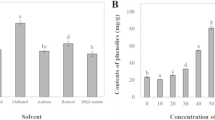Abstract
Prunus padus bark extract was tested for use as a natural cosmetic ingredient. P. padus bark extract was obtained by hot water extraction and succeeding maturing processes. Total polyphenol and flavonoid concentrations were measured, and safety test (cell toxicity test), efficacy tests (antioxidation, antiwrinkle, whitening), and temperature stability tests were conducted in experiments. Total polyphenol and flavonoid concentrations were 714.7±0.5 mg/g and 72.1±2.2mg/g, respectively. Compared with other natural antioxidants, polyphenol concentration in P. padus bark extract was extremely high. P. padus bark extract showed lower cell toxicity in 100–500 μg/ml concentration by MTT assay. P. padus bark extract indicated 71% DPPH free radical scavenging activity (antioxidation), 36% elastase inhibition (antiwrinkle), and 38% tyrosinase inhibition (whitening) at 350 μg/ml, respectively. W/O/W lotion formulation containing 1% P. padus extract was prepared and stability tests were done to see variations in cosmetic properties. Viscosity, pH, particle size, and appearance of lotion containing 1% P. padus extract maintained stable condition for 28 days. Particle size of lotions showed homogeneous 362–426 nm ranges during stability tests. From this study, P. padus bark extract displayed strong possibility as a natural antioxidative cosmetic agent.
Similar content being viewed by others
References
KDA Textbook Editiong Board, Dermatology, 5th Ed., Ryo Moon Gak, Seoul (2008).
J. D. Kim, S. J. Kim, H. S. Kim, K. H. Park, H. S. Lee and J. U. Jin, New Cosmetology, 2nd Ed., Donghwa, Seoul.
W. H. Kim, K. S. Lee and K. K. Lee, J. Soc. Cosmet. Scientists Korea, 38, 119 (2012).
P. Elsner and H. I. Mailbach, Cosmeceuticals and active cosmetics, 2nd Ed., Taylor & Francis, New York (2005).
ECOCERT, http://www.ecocert.com (2013).
Korea Minstry of Food and Drug Safety, http://www.mfds.go.kr/index.do (2013).
E. Lee, S. An, D. Choi, S. Moon and I. Chang, Contact Dermat., 56, 131 (2007).
http://www.wikipedia (2014).
J. H. Choi, D. S. Cha and J. Jeon, J. Ethnopharmacol., 144, 379 (2012).
A. Z. Kucharska and J. Oszmianski, J. Sci. Food Agric., 82, 1483 (2002).
L. S. Einbond, K. A. Reynertson, X.D. Luo, M. J. Basile and E. J. Kennelly, Food Chem., 84, 23 (2004).
J. Zhu, X. Meng, Y. Wu, Y. Bao and Y. Li, Chinese J. Anal. Chem., 31, 689 (2003).
D. S. Na, M.C. Yang, K. H. Lee and K.R. Lee, Kor. J. Pharmacogn., 37, 125 (2006).
T. Gutfinger, J. Am. Oil Chem. Soc., 58, 966 (1981).
E. J. Seo, E. S. Hong, M. H. Choi, K. S. Kim and S. J. Lee, Korean J. Food Sci. Technol., 42,750 (2010).
T. Mosmann, J. Immun Method, 65, 55 (1983).
Y. D. Hong, D. S. Yoo, M. H. Nam, H.C. Kim, S. J. Park, S. S. Shin, J.W. Cheon and Y. H. Park, J. Soc. Cosmet. Scientists Korea, 38, 181 (2012).
T. Kim, S. Kim, W.Y. Kang, H. Baek, H.Y. Jeon, B.Y. Kim, C.G. Kim and D. Kim, Korean J. Chem. Eng., 28, 1839 (2011).
S. Cofrades, I. Antonious, M. T. Solas, A.M. Herrero and F. Jimenez- Colmenero, Food Chem., 141, 338 (2013).
A. Benichou, A. Aserin and N. Garti, Adv. Colloid. Interface Sci., 108, 29 (2004).
K.Y. Kyong and C. K. Lee, J. Soc. Cosmet. Scientists Korea, 32, 4 (2006).
G.Y. Lee, Ph. D Thesis, Yonsei University, Seoul, Korea (2000).
K. B. Kim, K. H. Yoo, H.Y. Park and J. M. Jeong, J. Korean Soc. Appl. Biol. Chem., 49, 328 (2006).
D. S. Na, M.C. Yang, K. H. Lee and K.R. Lee, Kor. J. Pharmacogn., 37, 3 (2006).
J. A. Nichols and S. K. Katiyar, Arch. Dermatol. Res., 302, 71 (2010).
M.V. Eberhardt, C.Y. Lee and R. H. Liu, Nature, 405, 903 (2000).
H. L. Jeong, H.W. Kim, J. H. Kim, J. H. Kim and D. Kim, Korean Chem. Eng. Res., 50, 610 (2012).
C. H. Lee, J. D. Shin, S. H. Bae, K. C. Kang and H. B. Pyo, J. Soc. Cosmet. Scientists Korea, 38, 263 (2012).
J.Y. Moon, E.Y. Yim, G. Song, N. H. Lee and C.G. Hyun, EurAsia J. BioSci., 4, 41 (2010).
S. S. Kim, C.G. Hyun, J. Lee, J. Lim, J.Y. Kim and D. Park, J. Appl. Biol. Chem., 50, 215 (2007).
N. Smit, J. Vicanova and S. Pavel, Int. J. Mol. Sci., 10, 5326 (2009).
T. Kim, H. J. Kim, S.K. Cho, W.Y. Kang, H. Baek, H.Y. Jeon, B. Kim and D. Kim, Korean J. Chem. Eng., 28, 424 (2011).
Author information
Authors and Affiliations
Corresponding author
Rights and permissions
About this article
Cite this article
Hwang, D., Kim, H., Shin, H. et al. Cosmetic effects of Prunus padus bark extract. Korean J. Chem. Eng. 31, 2280–2285 (2014). https://doi.org/10.1007/s11814-014-0146-8
Received:
Accepted:
Published:
Issue Date:
DOI: https://doi.org/10.1007/s11814-014-0146-8




